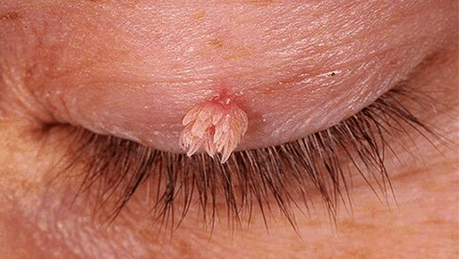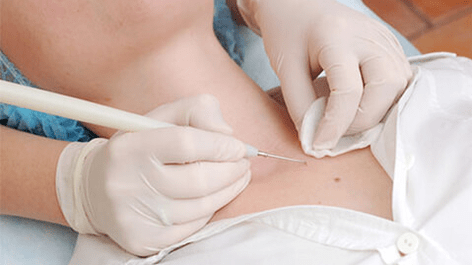
Many people on the skin have benign soft growths of flesh -colored.In most cases, they have a “leg”.In everyday life, such skin formations were dubbed warts.But in dermatology, they are called papillomas.
These neoplasms can occur on any part of the body.However, the most common are the armpits, neck and inguinal region.If you do not pay attention to them, then they are able to increase in size, injure when contacting clothes and bleed.
Why do skin polyps arise, whether to contact a doctor and how to get rid of them forever - we will consider in our article.
Why papillomas appear
The main culprit of this pathology is HPV or human papillomavirus.It has almost every person in the body.But not everyone has external manifestations in the form of growths.This is due to the fact that with good health, the virus is safely suppressed by immune cells.And after 2-3 years, in most cases, it independently disappears from the body.
What is this virus?HPV is a non -heating virus that is built into the DNA of the skin of the skin and mucous membranes.It is located on the surface, without leaving in the deep layers of the dermis.
Long months, and even years he is in a sleeping state.With a decrease in immunity for various reasons, the virus is activated and begins to grow.So papillomas arise.
Factors that negatively affect the immune system include:
- Constant stress.
- Poor or monotonous nutrition.
- Lack of vitamins.
- Chronic fatigue.
- Passive lifestyle.
- Bad habits.
- Malignant tumors.
- Transferred serious infectious diseases.
- Uncontrolled intake of antibiotics.
At risk are older people, since due to age -related changes the body is worse confronts the viruses.Often, skin formations often occur in children.The unformed immunity of the child is not able to cope with the virus.And he, after 2-3 months after infection, enters the active phase.
Important! If a person is infected with HPV, then it is impossible to completely remove it from the body.Either self -healing occurs, or it falls into a “hibernation” with increased immunity.
Risk factors for women
During pregnancy in women, natural inhibition of the immune system occurs.This is necessary so that the body does not perceive the embryo as an alien object, and gives it the opportunity to attach to the uterus.If a woman in the body has a human papillomavirus, then he will definitely use this moment.Therefore, in pregnant women the occurrence of papillomas is a common problem.
Risk factors for men
The causes of skin formations in men lie in alcohol abuse, frequent change of sexual partners, smoking.Bad habits negatively affect the state of general immunity, and the constant inhalation of tobacco smoke inhalations of the local protection of the oral cavity and respiratory organs.This can cause such a serious illness as papillomatosis of the larynx.
On average, the latent (hidden) period lasts from 3 months to a year.With strong health, an infected person remains just a carrier, without external manifestations.But the danger is that he is able to infect another person.
Ways to infect HPV
The causative agent is able to survive outside the human body for some time.Infection most often occurs by transmitting the virus through the contact-household path.It can be a handshake, touch, as well as the use of common household items, toys.Cases of infection in public recreation are frequent.These are baths, pool, water parks.
But to penetrate the dermal layer of the skin, one condition is necessary - damage to the skin.For infection, there will be enough microcracks or small abrasions.
In a newborn child, infection occurs along the vertical path, that is, from the mother-carrier in the process of childbirth or with breastfeeding.
Genital, pointed papillomas or condylomas are transmitted only through unprotected sexual intercourse.Self -extension is also possible, that is, the transfer of the virus from one part of the body to another.This happens when combing or injuring the growth, for example, during shaving.
The main types and types of papillomas
There are many HPV strains.Medicine is only known about 200 types of virus.Some of them affect only areas of the body, others - the mucous membranes of the genitals, and others arise in the oral cavity and larynx.
Among the known species there are types that have high oncogenic risk.For example, the most dangerous for a woman are viruses 16, 18 and 31.They are often detected with cervical erosion, and also cause its degeneration into a cancer tumor.The presence in the body of highly oncogenic types of virus does not mean that a person will necessarily have oncology.But this requires a more attentive attitude to health and observation by a specialist.
The following types of papillomas are distinguished by size and shape:
- Vulgar - These are ordinary, most common growths.Often appear between the fingers, on the sole of the legs, chin.Swear condyloma has a slightly stifled solid look due to walking and pressure.Often painful, but not cancer.
- Film or acrochords - They are characteristic of the elderly.Outwardly dense yellowish color.Tender growth over time.Always have a thin leg.They are localized by armpits, in the neck, in the skin folds and in the groin.Not capable of malignancy.
- Flat - Small numerous skin formations of a flat shape.They rise slightly above the skin.They have a bodily or slightly brown color.They are located on the face, in the upper part of the chest, in the area of the anus.Low risk of malformation.
- Sharp warts or condyloma - arise only on the genitals.The path of infection is predominantly sexual.Capable of rebirth into malignant education.
Some forms of HPV lead to a dangerous disease of the laryngeal papillomatosis.White plaque and growths prevent normal breathing, affect the vocal cords.This condition can lead to suffocation.Often this diagnosis is diagnosed in children.With a complicated current, the virus goes down, and affects the bronchi, lungs and trachea.
The danger of skin growths
Most of them do not pose a threat to life and health.They are only an aesthetic defect and cause psychological discomfort.
But, if papilloma is caused by a high level of oncogenicity, then under adverse circumstances, it can lead to an oncological diagnosis.Malignant education leads to strong intoxication, as well as metastases.
Factors that are able to provoke the malformation of education:
- sunburn and exposure to ultraviolet radiation;
- infection of papilloma as a result of its injury;
- Chronic inflammation in the body and persistent decrease in immunity.
Also, growths often grow, their number increases.They tend to merge into groups, as a result, a large affected area is formed.Rubbing clothes can lead to injury and bleeding of the growth.
When to see a doctor
Be sure to contact a dermatologist for inspection if the following changes are noticed:
- After injury, the wound does not heal.The release of fluid is observed, pain occurs when touching.
- The color of the formation has become darker.
- Papilloma began to increase in size.
- Distance of pus.
- The appearance of an unpleasant odor.
- Rubbing pain even at rest.
- Hair loss in the zone of the growth.
Any skin education is subject to examination and observation with a genetic predisposition to oncology.If papillomas bring discomfort in everyday life and interfere, then they are subject to mechanical removal.
Diagnosis and treatment of papillomas

Depending on the place of localization, you should contact a dermatologist, gynecologist or urologist.The following studies are necessarily conducted to evaluate the growth:
- Dermatoscopy is a detailed study of papilloma through a magnifying device.
- Blood test for the detection of antibodies to HPV.
- PCR diagnostics.
- The capture of biomaterial for histology (with suspicion of malignancy of education).
In vaginal formations, the doctor takes strokes from the urethra or cervix.The analysis is carried out for the availability of STIs.Diagnostics in the presence of a condy is carried out by both partners.
With multiple rashes, it is possible to conduct an analysis for checking the immune status.
Therapy of the disease is aimed at suppressing the virus and increasing immunity.For this, preliminary removal of all growths, as sources of the virus.Then antiviral therapy and intake of immunomodulators are carried out.
Methods of removal of formations
Depending on the size and place of the location, the doctor may offer the following methods of operational removal.

- Cryodestruction or exposure to liquid nitrogen.
The disadvantage of this method is that the specialist cannot accurately control the depth of exposure.Because of this, burns or incomplete deletion of education are possible. - Laser removal
This is a modern method that allows you to get rid of several formations in one session.Does not leave scars or scars.It does not lead to bleeding, since the process of paleting blood vessels occurs.Has a number of contraindications. - Electrocoagulation.
This method involves the impact on the growth using the electrode.Effective for protruding papillomas that have a leg.It is used in the intimate area.Advantage: A remote growth can be sent for further laboratory research. - Radio wave method or method of radio -bearer.
A specialist can individually choose the length and strength of the radio wave, given the depth of the growth.It is carried out using the Surgitron apparatus.Healthy cells are not damaged, a point effect on the growth with a thin electrode occurs.Rehabilitation is not required.
In rare cases, surgical excision of education is used.It is used for large formations or in the presence of signs of malignation.This is the most radical, but effective method.Subsequent recovery is required.Often there is a small scar.The risk of relapse is minimal, since the surgeon completely removes the growth, affecting the healthy area.An operation is underwent under local anesthesia.
Single ordinary papillomas can be removed using special chemical compounds.They contain alkali or acid in the composition.But with this method there is a great risk of burning.In addition, with incomplete removal of the growth, new formations often arise.Independent withdrawal of formations can lead to serious negative consequences.
Preventive measures
It is possible to completely protect yourself from infection with HPV only with vaccination.But it is advisable to spend it only before the start of sexual activity.It protects only from the most dangerous types of the virus that can lead to oncology.
To reduce the risk of papillomas, it is necessary to observe elementary rules.
- In public places of rest, do not walk barefoot.Use only your shoes.
- In public toilets, use disposable lining.
- Use a condom for oral and vaginal form of sex.But this will give only 50% protection, since there is enough simple bodily close contact for infection.
- Strive for a monogamous relationship.
- To minimize close communication with an infected person who has external manifestations of the disease.
Particular attention should be paid to health if pregnancy is planned.To do this, first hand over the HPV detection test.
To avoid relapse of the pathology after removal, you need to accurately observe all the doctor's recommendations.You should take care of immunity, supporting it at the optimal level.To do this, you need to eat properly and fully, play sports and abandon bad habits.
The very presence of HPV in the body is not a reason to sound the alarm and begin increased treatment.But if the skin is found on the skin, it is better to consult a doctor.























